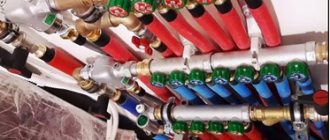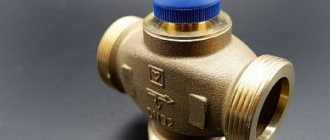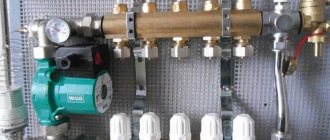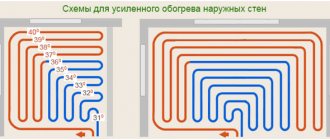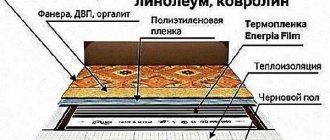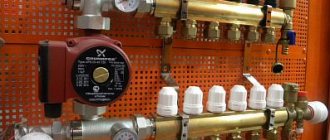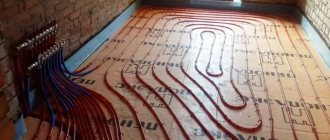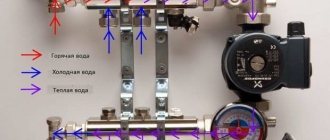Thermostats designed to control heating with electric heated floors have a special designation.
Do not confuse them with other popular models that are produced to work with gas boilers or water heating through a manifold.
On the back of the device between the two terminals, look for an image in the form of a snake (pins L1 and N1).
This is where the cable for a warm floor or electric mat is connected.
To the end of L1 is the central core of the cable, to N1 is the braid.
An external temperature sensor that prevents overheating of heated floors and controls heating is mounted on blocks with a sensor image (NTC).
The polarity of connecting the sensor wires is not important. Connect them in any order.
Temperature determination error
Please note that the temperature directly at the remote sensor will always be higher than the temperature in the room, which the regulator shows on its display.
This is due to the depth of the sensor in the screed.
Usually this delta, between t on the floor surface and t inside the screed, does not exceed 5-7 degrees.
On the displays of electronic devices you can see both parameters, but in mechanical devices with a wheel, degrees are often not even written around the circumference, but only the numbers 1-2-3, etc. are indicated.
With five digits, one division corresponds to approximately 8 degrees.
Degrees are not indicated for a specific purpose, so as not to confuse the user. You set the thermostat housing to +25C, but the room thermometer in the apartment will only show +20C.
Most people will immediately ask the question: why does the regulator operate with such an error? Is it broken?
No, he's fine. In this case, the sensor in the floor warms up to +25C, not the air in the room. That is why manufacturers simply indicate numbers in mechanics, so that you, focusing only on your feelings, can choose the most comfortable mode for yourself.
If degrees are indicated on your mechanical thermostat, this means that it mainly works and is guided by its own air temperature sensor built into the housing.
The one that is connected to it from the outside and hidden in the tie only plays the role of protecting the cable from overheating.
Supply 220V power to terminals L and N through an RCD with a leakage current of no more than 30mA.
The diagram for connecting a heated floor directly through a thermostat from different manufacturers is the same and looks like this.
Types of electric floors
Electric floors have a common power source, but differ in the design of the heating elements. To find out how to properly connect a heated floor, you need to clarify what type of floor you plan to install.
The following can act as a heating base:
- resistive heating cable (single or two-core);
- self-regulating cable;
- thermal mats (thin conductor laid on a mesh);
- heating film (carbon or bimetallic);
- carbon rods.
There is a different connection diagram for an electric heated floor for each of the above options.
When installing a cable floor, it is necessary to correctly calculate the laying step to avoid excessive heat generation or uneven heating of the surface.
Heating mats and film are purchased based on the manufacturer’s recommendations, which are usually indicated on the packaging.
Connection diagram for high power heated floors
When connecting, be sure to check the power that the thermostat can pass through. Usually it is designed for a load of no more than 16A (3.7 kW at a voltage of 230V).
This is exactly the maximum value. It is recommended to use the device under a constant load of no more than 70% of this power.
In this case, the device will last a long time and function properly. The switch that switches the contact quickly fails when overheated. And along with it you will have to change the entire device.
For loads greater than 3.7 kW, a modular contactor will be required.
The connection diagram in this case will change to the following.
Here, instead of the load, the wires from the regulator go to the contacts of the switching coil (A1-A2), and the heating cable itself is connected to the power terminals of the starter (1-2 or 3-4).
What is a thermostat, purpose, principle of operation
The operation of a thermostat is based on a cyclic process of closing and opening an electrical circuit. Microclimate regulation according to this parameter is based on signals sent by the temperature sensor. Let's look at this process in more detail:
- When a given temperature threshold is reached, the resistance of the internal sensor increases.
- The thermostat opens the electrical circuit.
- As the sensor cools down, the resistance increases again.
- The thermostat starts up again, but no longer opens, but closes the electrical circuit.
This cycle continues for a specified time and allows us to talk about automatic setting of the temperature in a room equipped with an infrared heater. Its advantage is that it heats surrounding objects, and the thermostat makes it easier to control this process.
Phasing on the thermostat
A common question is: is there a difference where to connect the phase on the thermostat and where to connect the zero?
Yes, I have. This does not affect the operating logic of the device, but it does not affect the safety.
If you confuse the phase and zero, then when the thermostat is turned off, it will not be the phase conductor that will break, but the neutral one. Thus, the phase will be constantly present on the underfloor heating cable, which is naturally not safe.
In those devices that have a separate switch on the case, when it is pressed, two conductors are broken at once, both phase and zero. But this is in manual shutdown mode, and not in all models.
Often the zero is fed directly through its track. I went into the terminal and immediately went to the heated floor.
In this case, the switch itself is only responsible for interrupting the power supply to the control board. When automatically triggered by a sensor, only one wire is always broken.
Key Safety Points
Any electrical installation work must be carried out in strict accordance with safety precautions. Neglect of these provisions may result in the most unfavorable consequences. The key recommendations are:
- before starting work, turn off the power to the entire apartment/house or directly to the line allocated for connecting the thermostat, if such a possibility exists;
- Do not connect a disassembled device to the mains;
- do not use the regulator at temperatures above +40 and below -5;
- do not allow the thermostat to become dusty;
- Do not use any solvents to clean the device. The use of benzene for these purposes is also unacceptable;
- do not repair the regulator without the appropriate skills;
- do not exceed the power and current values specified in the manufacturer's instructions.
Do you need land?
Also note that the protective grounding is directly to the thermostat itself at class=”aligncenter” width=”700″ height=”434″[/img]
This can be a separate, separate terminal through which the heating cable shield is connected to the protective conductor.
The thermostats themselves even have a “square within a square” icon, which means a device with double insulation.
These marks are typically found on portable tools that do not require a grounding pin on the power cord plug.
Which thermostat to choose
If you need to choose a regulator to connect to a heated floor in a small room, for example, in a bathroom or kitchen, then you can choose a mechanical device. Typically, heating such a room does not require a large amount of electrical energy, and the heating rate will be high. It is simply impractical to program temperatures and operating times in such rooms.
If the room is spacious, then to warm it up you need a larger resource of electricity, here temperature adjustment will be significant. You can turn on the heated floor in cases where there are household members in the room. In this situation, it is better to use software and digital thermostats. Even taking into account their high cost, these funds will be repaid in the future by energy savings.
Advice! You should pay attention to the power of the device. If there is a risk of exceeding the permissible power level, then it is better to connect a programmed version.
The difference between expensive electronic thermostats and mechanical ones
What super-tasks are solved by smart thermostats filled with electronics and a display? It would seem, why buy an expensive product if you can buy a regulator with a mechanical wheel and set the desired temperature for yourself in the same way?
And the point here is one of the fundamental problems of comfortable operation of heating systems - inertia.
The fact is that having set an acceptable temperature on warm floors in the region of 23-25C, after reaching it, even with the heating device turned off, the system will still continue to gain degrees by inertia up to a certain point.
The same applies to the minimum parameter. In fact, such fluctuations in a room can reach from 19 to 27C.
There is no question of maintaining comfortable conditions with such variations. In smart electronic thermostats, all this is solved by PWM regulation.
This term comes from radio electronics. There PWM is pulse width modulation. In heating, this principle consists of changing the switching time and operation of the heating elements.
While the temperature in the room is far from the desired parameters (set at +25C, in the room +18C), the heated floors are turned on all the time (heating, heating and heating).
However, as the set point is reached (+25C), heat begins to be supplied as if in small, short pulses (on-off). Due to this, the temperature is accurately maintained in a comfortable area.
In this case, you can forget about inertial processes associated with overheating or, conversely, excessive cooling. You won't get anything like this from a thermostat with a wheel.
Manual adjustment of TP collectors
The simplest, although time-consuming, setting method is to adjust the temperature of the heated floor using manual valves. The task is somewhat simplified by installing flow meters (rotameters) on the comb.
Flow meters simplify the dosage of the amount of circulating coolant (flow) in one separate circuit of the underfloor heating system. In the case of group temperature control throughout the collector, the rotameter can also be used to balance the flow of coolant (smoothing out the difference in hydraulic resistance) along loops of different lengths.
The main elements of a flow meter valve are:
- housing with shut-off and control valve. It is screwed into the corresponding technical hole of the manifold;
- a flask made of transparent plastic or glass with a printed scale;
- float indicator that allows you to visually control the flow of liquid through the rotameter.
Manual adjustment of the underfloor heating manifold is carried out by screwing/unscrewing manual valves or adjusting the throughput of flow meters.
The sequence of manually setting the temperature of a warm water floor
At the beginning of the adjustment operations, it is necessary to make sure that the pipelines of the TP system (secondary circuit) are completely filled with coolant and have no air pockets. They are filled following the main heating system (primary circuit). At this time, all shut-off and control valves on the collectors must be closed.
After opening the main valves for the supply and return of the distributors for heated floors, the shut-off devices on each of the loops are opened sequentially. Air is bled through Mayevsky valves or automatic comb air vents. It is recommended to fill the next branch only after the previous one has been completely filled and its air has been guaranteed.
Having completed filling the first loop, it is necessary to turn on the heat pump of the secondary heating circuit and circulate the coolant through its system. The efficiency of liquid circulation is checked with built-in or overhead thermometers. As a last resort, you can simply put your hands on the supply and return pipes at the same time - they should be warm, but with a slight difference in heating.
The filled first loop should be cut off from the collectors at both ends using local shut-off and control valves. Then, the above actions are carried out with the next loop.
After sequential filling of all heat pump circuits, their shut-off devices are opened and the heat pump is switched on to operating mode. The temperature of the warm water floor is adjusted through the supply of coolant to each of its branches. It is set by changing the liquid flow rate (with a valve or rotameter), and control is carried out by changing the temperature gradient between the supply and return flow. Ultimately, this difference for different circuits should be the same, within 5-15C. The longer the loop, the more intense the coolant will cool and the greater its consumption required.
To monitor the correct adjustment of a warm water floor, it is rational to use non-contact laser or contact electric thermometers. Their installation to measure the temperature of the supply and return pipes will help reduce the time to obtain the result of changing settings from several hours to 10-15 minutes.
Thermostat is not working - how to check?
At the same time, do not expect any major changes when replacing a thermostat from one model to another. There is an opinion that if the warm floor does not heat up, then it is worth changing the thermostat to a more expensive one, everything will change by itself.
The air temperature in the room will immediately rise, and where it was previously cold, it will become hot. Roughly speaking, the thermostat is like the speedometer in your car.
You can draw 300-350 km/h on the speedometer, but if the engine is not capable of producing such power, then you will not see this speed. If something is to blame for the poor performance of heated floors, then first of all look at the temperature sensor.
Checking the functionality of the thermostat is very simple. Supply it with 220V power and connect the remote sensor.
Next, instead of a warm floor, connect a regular incandescent light bulb to the thermostat. You begin to unscrew the knob, changing the temperature.
At a certain moment the light should light up.
Next, hold the temperature sensor in your hand and wait. When heat comes from your body, a working thermostat will turn on and the light bulb will go out.
If the sensor is hidden deep in the screed, you can warm up the area with a hairdryer and wait for the same effect. When the lamp does not react at all, this indicates a malfunction of the device.
The fastest way to repair in this case is to transfer the work from the floor sensor to the air sensor built into the housing.
The ends of the cable on the device from the floor temperature source will have to be unscrewed, and the settings of the device itself will have to be reset.
All this will work correctly provided that the thermostat is installed directly in the heated room.
If you have an electronic thermostat with PWM control, then using the above test method, it is not recommended to heat the sensor too quickly with an extraneous heat source. What does this mean?
Firstly, the thermostat will immediately detect an abnormal increase in heat and work ahead of time. Secondly, the “smart brains” of the device will forcibly turn off the heating for the next 20 minutes.
In this case, after just 5 minutes the temperature on the device’s display will be sufficient to turn on, and startup and contact closure will not occur. As a result, you will have doubts about the correct operation of the thermostat.
Therefore, the fast heat test is ideal for mechanical devices, but be careful with electronic ones.
Kinds
There are several types of thermostats, all of them differ in the principle of operation and the number of control channels. Depending on the principle of action there are:
- mechanical;
- software;
- digital.
Taking into account the number of control channels:
- with two zones - they work simultaneously in two heating areas;
- single-channel – regulate one sensor.
Also, depending on the installation method, there are built-in or wall-mounted thermostats.
Mechanical
The simplest device at an affordable price. Equipped with a circular switch on the outside of the device. To set the operating mode, the switch must be turned clockwise. Mechanical devices can be equipped with several types of adjustment at once. In this case, turning off and turning on the device will be manual and not automatic.
Mechanical thermostat
Digital
This thermostat is more modern. It can control temperatures with maximum precision. There are built-in or surface-mounted devices. Some products are equipped with a touch panel, while others have control buttons.
Thanks to the presence of an electronic display, it is possible to set the exact operating temperature of the underfloor heating. Also, connecting this thermostat provides several useful functions: automatic shutdown when sufficient heating occurs, the ability to install a separate power supply to save electricity consumption.
Digital thermostat
Programmable
This type has the highest operating efficiency, but the disadvantage is its high cost. Built-in thermostats can have compact dimensions, and wall panels are equipped with touch controls. Thanks to the introduction of an electronic system, it is possible to perform precise programming of temperature levels and set a timer for turning the system on or off. All data on the operation of the heated floor will be reflected on the front panel. This operating principle allows you to save energy consumption.
Programmable thermostat
Combined
This control unit combines the functions of a mechanical and automatic device. Switching on is done manually. The device is equipped with a remote control, which makes it possible not to install the thermostat on the wall and not spoil the overall interior of the room.
Connecting a temperature sensor
Another error occurs when replacing or connecting sensors from different manufacturers to the same regulator. The fact is that they all have a certain resistance corresponding to a particular temperature.
And if you change the temperature sensor to another without changing the settings, this may lead to incorrect heating operation. The difference in temperature between the detected and actual temperature can reach 10 degrees!
Due to a different resistance, less than the factory one, the regulator will understand this as an excessive temperature and give a command to turn off early, although the heated floors will not yet be warm enough.
For heated floors, so-called NTC sensors are used - negative temperature coefficient sensors. This term means that as the ambient temperature increases, their resistance decreases.
There is also PTC - positive t coefficient. resistance. The reverse process occurs with them.
Advanced devices (Devireg Touch) initially have several types of sensors included in the settings program. At the installation stage, simply select the required one.
If you don't know the brand, you will have to manually measure the resistance with a multimeter.
The received data is compared and checked whether they correspond to the factory settings or not.
The most correct heating system is considered to be one that has its own control zone in each room. What does this mean?
If there is only one thermostat in the house, the temperature spread in different parts of the building will reach 5-6 degrees.
Therefore, you will have to buy and install not one, but several thermostats.
You can set separate controllers for two zones simultaneously, while changing the temperature priority. That is, install it in a thermostat in one room, and run a remote sensor from it into the next room.
In this case, in the settings you will need to select which element the thermostat should respond to - one built into the housing or an external one. You will not be able to achieve the same temperature from one device.
It is prohibited to place thermostats in wet areas. They must have an appropriate IP level of moisture protection and be installed in zone 3.
What kind of zone this is, read in a separate article.
Operating principles and connection of the thermostat
Based on their design, thermostats are classified into complex electronic ones with programmable control and simple mechanical ones. In the latter, unlike electronic ones, equipped with an electrical unit and a display, only the temperature is set mechanically. However, despite the variety of devices, the circuit diagram for connecting the heated floor controller is very similar. There is no danger of making a mistake, since the specific diagram of each of them is indicated on the case.
The switching power of the device must correspond to the selected heating system.
According to modern standards, the maximum permissible power of a thermostat is taken to be 3 kW.
The main function of a thermostat is to maintain a constant temperature in the system. Having received information from the temperature sensor that the required limit has been reached, it automatically turns off the power. At the same time, the thermostat and temperature sensor continue to work. As soon as the sensor gives a signal about a change in temperature, the regulator will immediately turn on the power.
In a warm field with water heating, installing a thermostat is not necessary. Nevertheless, it is recommended to include it in the system if saving mode is important or the room is heated from several sources.
Installing a thermostat
The thermostat is mounted on the wall above the floor level by at least 1.5 m. The device is connected to power either from a panel or through a socket, but in both options, a prerequisite is the presence of an additional circuit breaker connected to the network, which should operate in an emergency situation, be it this is a breakdown, overheating or short circuit.
On the side of the thermostat there are “sockets” where power cables, temperature sensor wires and the cold ends of the heating cable are fed. As a rule, the connection diagram is shown on the device, which undoubtedly greatly simplifies installation. If there is no scheme, then they act according to the standard:
- terminal No. 1 – network phase;
- No. 2 – network zero;
- No. 3, 4 – heating cable cores;
- No. 5 – timer;
- No. 6, 7 – floor temperature sensor.
It is useful to know that all supply wires have different color markings for: L phase - white (black, brown),
N zero – blue,
“earth” – yellow-green.
To connect the floor to the thermostat, you will need to cut a shallow ditch in the wall. Two PVC tubes will pass through it - one for the cold ends of the heating element, the other for the temperature sensor.
Now we can consider the preparation for connecting the heated floor completed.
Choosing a location to install the thermostat
When choosing a location for placing a thermostat, several factors are used.
- Device type. In the retail chain you can most often find built-in thermostats, but if it is impossible to install it, you can find a design designed for wall-mounted installation.
- Ergonomic considerations. The regulator is placed in a convenient place, at a height of 10–80 cm from the floor.
- Availability. It is best to install the thermostat near the doors. In this case, you don’t have to worry that after a while, access to the device will be impossible due to standing furniture or equipment.
- Rational use of materials. When choosing a location, you should take into account the distance from the electrical panel and the location of the cables, since these factors affect the consumption of electrical wiring.
When using heated floors as the main heating, a thermostat with a built-in sensor is often used. Since the device operates depending on the air temperature in the room, it is installed at a height of about 150 cm from the floor.
Review of prices in various CIS cities
If you need to buy a regulator to control your underfloor heating system, the information in the table on the average cost of the Teplolux TR-515 device in various cities of Russia and the CIS may be useful.
| City | Cost (USD) | City | Cost (USD) |
| Ekaterinburg | 43,4 | Kazan | 43,5 |
| Donetsk | 45,2 | Minsk | 45 |
| Moscow | 42,3 | St. Petersburg | 42,3 |
Considering the prevalence of this model and the manufacturer’s wide dealer network, the cost variation in different regions is insignificant; we are confident that in Novosibirsk or other cities the price for a heated floor regulator will be approximately the same.
Return line
Warm floor → 35 °C → Check valve with outlet → 35 °C → Boiler
To install the circuit, use one of the types of three-way valves:
- With thermostat function. Adjustment of the pressure of mixed flows plus maintaining the set temperature.
- With remote sensor. Adjusting the intensity of hot water supply.
Automation controls the temperature of the water supply to the VTP. According to the specified parameters, the thermoelectric servo drive closes and opens the valves of the distribution manifold. It blocks the passage of hot coolant, and when the water in the system cools, it raises its rod, mixing the flows.
Water heated floors are suitable for connection to a heating system only in private housing. In city apartments or high-rise buildings, such installation is impossible for technical reasons.
The maximum effect from HTP is achieved with the help of autonomous heating sources. The best option is a gas boiler, which heats the circulating coolant to 45–50 °C.
If the system is correctly connected according to the most effective scheme for specific rooms, the heated floor will last for a long 30–50 years.
Balancing valve
Uniform heating of the floor surface is achieved by introducing additional devices into the design. This is the advantage of connecting the EHP to existing heating sources.
The balancing valve in the water heated floor connection diagram regulates the flow rate of the cooled coolant.
| Room area | Valve position |
| > 20 sq. m. | Open |
| < 20 sq. m. | Covered |
